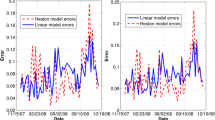Abstract.
In the present paper we construct stock-price processes with the same marginal lognormal law as that of a geometric Brownian motion and also with the same transition density (and returns' distributions) between any two instants in a given discrete-time grid.
We then illustrate how option prices based on such processes differ from Black and Scholes', in that option prices can assume any value in-between the no-arbitrage lower and upper bounds.
We also explain that this is due to the particular way one models the stock-price process in between the grid time instants that are relevant for trading.
The findings of the paper are inspired by a theoretical result, linking density-evolution of diffusion processes to exponential families. Such result is briefly reviewed in an appendix.
Similar content being viewed by others
Author information
Authors and Affiliations
Additional information
Manuscript received: March 1998; final version received: March 1999
Rights and permissions
About this article
Cite this article
Brigo, D., Mercurio, F. Option pricing impact of alternative continuous-time dynamics for discretely-observed stock prices. Finance Stochast 4, 147–159 (2000). https://doi.org/10.1007/s007800050009
Issue Date:
DOI: https://doi.org/10.1007/s007800050009




